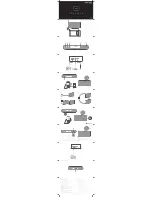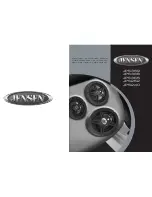
Page 7
6. A Tour of SAT 6.5 MK II
Amplifier & Electronics
1.
XLR INPUT 0dB
- This XLR input should be connected to a bass-
managed output which includes a 12dB per octave 80Hz high-pass
filter, such as the bass-managed outputs on the SUB 15, SUB 12, or
BMC. This input is electronically balanced. Do not connect more
than one source to this input. With the gain control on the SAT 6.5
MK II set to the reference mark, and the input attenuator set to
the +24dBu setting, a 200mV (-11.7dBu) pink noise signal, with a
bandwidth of 500 to 2kHz, will yield 90dB SPL at 1 meter. Refer to
page 9 [System Signal Flow & Connections] for more information.
2.
12dB Input Attenuator Dip-Switches
- These dip-switches
control the 12dB input “pad” on the XLR Input. With both dip-
switches in the +24dBu position, the -12dB pad is in circuit. With
both switches in the +12dBu position, it is out of circuit. The 12dB
input attenuator, in combination with the gain control (Item 4 on
this page), allows the user to adjust the gain from REF (200mv of
500 to 2kHz pink noise = 90dB SPL @ 1M) to -24dB.
3.
Power LED -
This power LED indicates the SAT 6.5 MK II is
powered ON.
4.
GAIN -
This trim pot is a continuously variable gain control, with a
range of -12 to REF (200mV of 500 to 2kHz pink noise = 90dB SPL
@ 1M). In combination with the -12dB input pad, it allows for a
range of -24dB to REF.
5.
Amplifier Heatsink -
The heatsink provides essential cooling to
the amplifiers inside the 6.5 MK II. Please ensure that proper air
circulation is available for cooling.
6.
Voltage Selector Switch -
This switch can be set to either 115
Volts or 230 volts. Prior to powering this unit, please confirm that
the Voltage selector switch has been set to the correct voltage
setting. If you are unsure of the type of power that is supplied to
your studio, consult your product dealer or local power company.
If your changing the Voltage, also confirm the proper fuse is
installed [see number 8].
7.
Power Switch -
Controls the power the internal amplifiers and all
internal electronics.
8.
FUSE -
Replace with same rating and type for your local voltage
rating. For 115V applications use a 2.5 Amp T 250V and for 230
Volt applications use a 1.25 Amp T 250V fuse (“T” = Time Delay or
SloBlo type fuse).
9.
IEC RECEPTACLE
- Check voltage selector switch before connecting
power. Connect to 115 Volt AC / 60Hz power source, rated for 250
WATTS or 230 Volt / 50Hz rated for 250 WATTS.


































